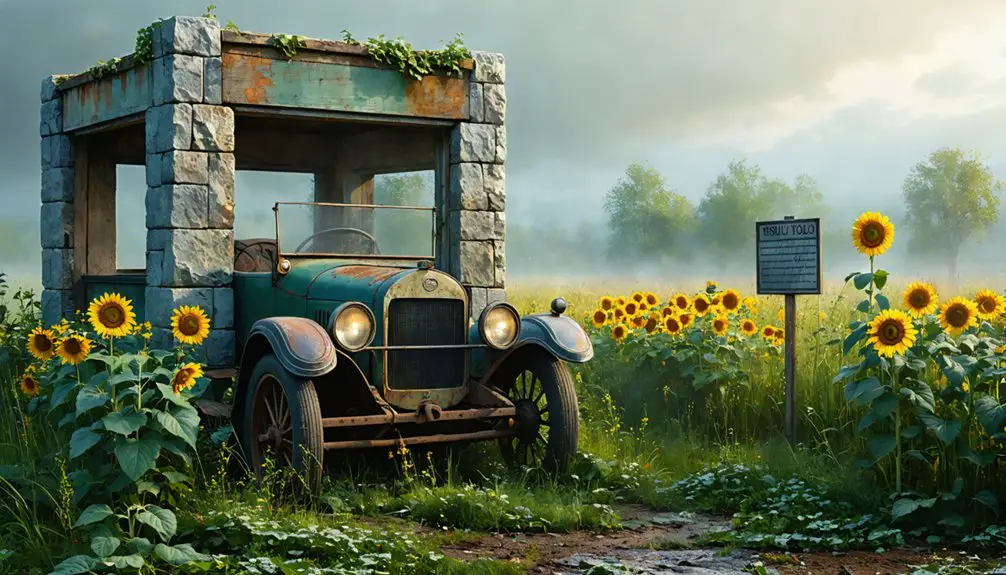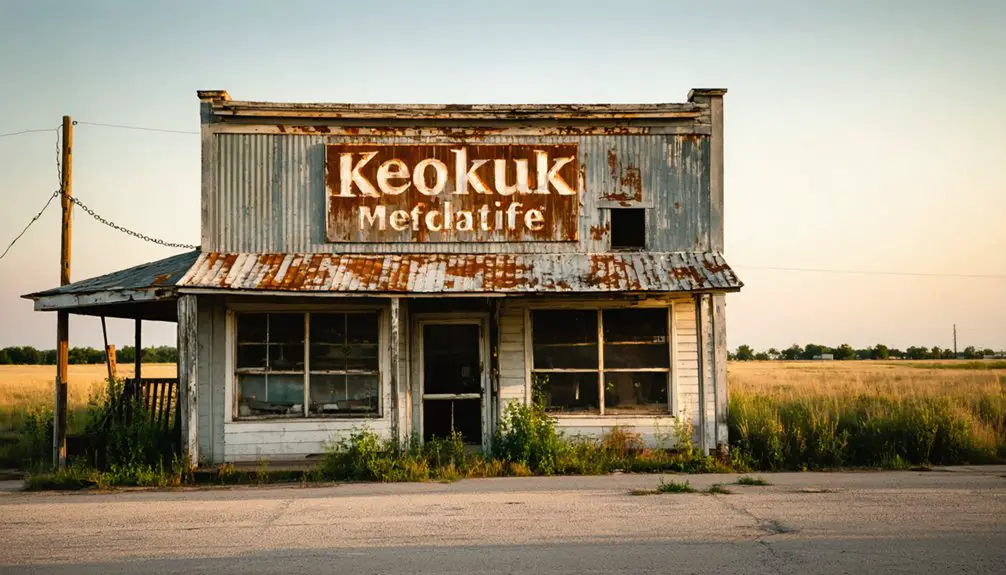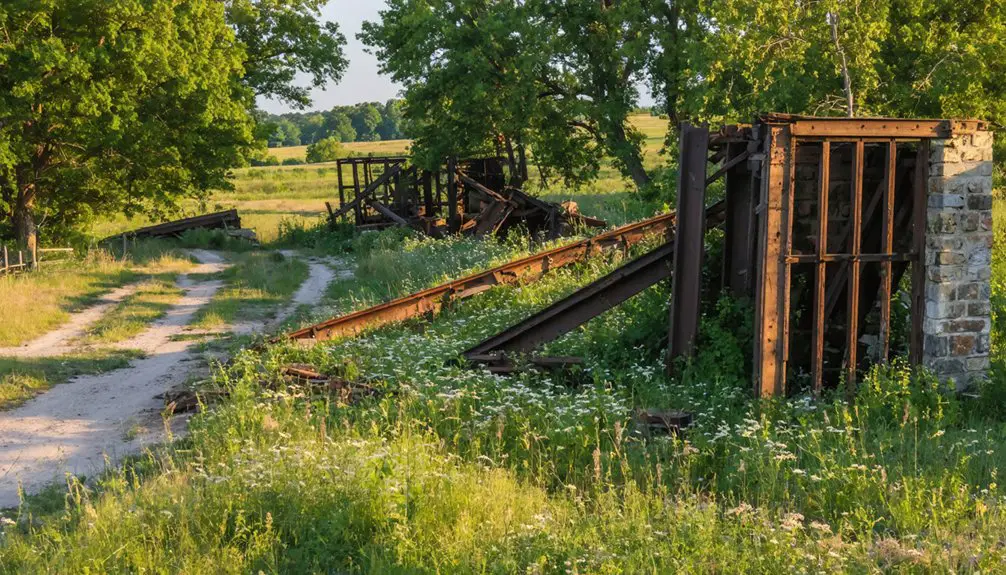You’ll find Keokuk Falls‘ haunting remains in Oklahoma, where Moses Keokuk and the Sac & Fox tribe established it in 1869. The town gained notoriety for its seven saloons, including the infamous Black Dog Saloon, serving whiskey at ten cents a shot. Daily gunfights and bootlegging operations defined this wild frontier settlement until Oklahoma’s 1907 statehood enforced prohibition. The ghost town’s empty buildings still echo tales of lawmen, outlaws, and the notorious Pretty Boy Floyd.
Key Takeaways
- Keokuk Falls was established in 1869 by Moses Keokuk and the Sac & Fox tribe, later becoming a thriving saloon town.
- The town was notorious for its seven saloons, including the Black Dog Saloon, which dominated the local economy before statehood.
- Daily violence, gunfights, and illegal whiskey trade characterized the town’s peak period between 1891 and 1907.
- Oklahoma’s statehood in 1907 brought strict prohibition laws, forcing all saloons to close immediately.
- The town rapidly declined into a ghost town after 1907 due to economic collapse and mass exodus of residents.
The Birth of a Frontier Town
While the establishment of many frontier towns followed predictable patterns, Keokuk Falls emerged with a distinctive origin tied to both Native American history and Oklahoma’s dramatic land runs.
You’ll find the town’s roots in frontier migration, beginning when Moses Keokuk led his Sac & Fox tribe from Kansas to the area in December 1869. The settlement truly took shape after the second Oklahoma land run on September 22, 1891, as homesteaders like the Benes, Kluts, White, and Homan families arrived to stake their claims.
The community struggles became apparent as the town’s character formed around D.N. Beaty’s Black Dog Saloon, the first business to open its doors. Located seven miles southeast of Prague, the town would soon become a magnet for both settlers and troublemakers. Like many other whiskey towns along the boundary, Keokuk Falls thrived until Oklahoma achieved statehood in 1907.
This establishment set the tone for what would become one of Oklahoma Territory’s most notorious liquor towns, laying the foundation for both commerce and conflict.
Seven Deadly Saloons and Wild West Culture
Keokuk Falls earned its notorious reputation through the infamous “Seven Deadly Saloons,” establishments that transformed this frontier settlement into one of Oklahoma Territory’s most dangerous towns.
Starting with D.N. Beaty’s Black Dog Saloon in 1891, these drinking establishments, with their typical saloon architecture of wooden boardwalks and swinging doors, became social hubs where outlaws, desperados, and rough characters gathered.
You’d find bootlegging operations supplying illegal liquor to Indian Territory, while inside, gambling and violent confrontations were daily occurrences. The town’s two distilleries kept the whiskey flowing, attracting figures like Pretty Boy Floyd. Located along OK-99 Highway, the town became a strategic point for distributing illegal spirits across the region.
Law enforcement struggled to maintain order, with marshals often meeting violent ends. Blood-soaked boardwalks testified to the frequent gunfights and knife fights that erupted around these notorious establishments. The legendary Judge Isaac Parker attempted to bring law and order to the dangerous town, but violence persisted until Oklahoma achieved statehood.
Law and Disorder on the Streets
The streets of Keokuk Falls erupted daily with gunfire as outlaws and lawmen clashed in frequent shootouts, including the notorious incident where saloon owner Ed Thomlinson killed the town’s first marshal.
You’d find desperadoes congregating at the “Seven Deadly Saloons,” which served as staging grounds for criminal activity and violent confrontations that kept Marshal John Turner and Deputy Sheriff Gene Lomax constantly overwhelmed. Their inability to establish law and order stood in stark contrast to modern police departments’ core values.
The town’s dependence on saloon revenue created a perfect storm of lawlessness, where alcohol-fueled brawls and armed standoffs became so commonplace that they’d define Keokuk Falls’ reputation as one of Oklahoma Territory’s most dangerous settlements. Like many liquor towns near dry territories, it thrived by serving alcohol to residents from neighboring areas.
Gunfights and Daily Violence
During its turbulent heyday, daily life in this Oklahoma frontier town revolved around an explosive mix of cheap whiskey and deadly gunplay.
You’d find whiskey flowing freely at just ten cents a shot in the notorious “Seven Deadly Saloons,” fueling endless street battles and gun violence. The town’s boardwalks regularly ran red with blood as disputes erupted into deadly confrontations. Born in 1888 by Henry C. Jones, Keokuk Falls quickly gained notoriety as a haven for outlaws and violence.
- Stagecoach passengers routinely witnessed killings within minutes of arrival
- Lawmen faced constant deadly showdowns, with many dying in the line of duty
- One fierce gunfight left multiple casualties and dead horses on Main Street
- The lack of proper jail facilities made containing violence nearly impossible
The combination of bootlegging operations, outlaw hideouts, and cheap liquor created a powder keg atmosphere where you’d need to watch your back constantly to survive another day.
Marshal vs. Outlaw Encounters
As frontier lawmen patrolled Keokuk Falls’ dangerous streets, they’d routinely face deadly showdowns with notorious outlaws drawn to the town’s lucrative whiskey trade.
Marshal tactics often involved forming posses to counter outlaw strategies of ambush and armed resistance, but law enforcement faced constant undermining from corruption and local sympathizers.
You’ll find that some of the most violent encounters stemmed from the town’s first distillery in 1899, where saloon disputes frequently erupted into lethal confrontations.
In one notable case, saloon owner Ed Thomlinson killed a local marshal but earned exoneration when evidence showed the lawman drew first.
The brutal cycle of violence continued until 1905, when citizens finally voted the town dry, effectively dismantling the whiskey-fueled power structure that had long protected outlaws and challenged law enforcement authority.
Seven Saloons Create Chaos
Seven bustling saloons dominated Keokuk Falls‘ main thoroughfare, transforming this frontier outpost into a powder keg of lawlessness and social upheaval.
The saloon culture attracted a volatile mix of cowboys, outlaws, and drifters, while frontier nightlife erupted in frequent brawls and gunfights along the blood-stained wooden sidewalks. Notably, Pretty Boy Floyd frequented these establishments during his outlaw days.
Located near Indian Territory’s border, where liquor was prohibited, these establishments fueled illegal trade and attracted those seeking to escape regulation.
You’d find the streets teeming with dangerous characters as rival saloons competed for business.
- Gambling halls operated without restriction
- Dance halls drew rowdy crowds nightly
- Outlaws dispensed their own brutal justice
- Wooden walkways bore witness to countless violent encounters
The concentrated presence of these seven saloons created an environment so chaotic that law-abiding citizens struggled to establish any semblance of order.
Notable Characters and Local Figures

While many frontier towns had their share of colorful characters, Keokuk Falls’ roster of notable figures reflected its unique position as a notorious “whiskey town” on the edge of Indian Territory.
You’ll find outlaw legends woven through the town’s history, with gunfighters seeking refuge in its saloons and outlaws exploiting the jurisdictional confusion between territories.
Saloon stories tell of wealthy proprietors who built their fortunes on the liquor trade, while lawmen struggled to maintain order on bloodstained wooden sidewalks.
Between outlaw shootouts and whiskey profits, Keokuk Falls’ saloons painted a stark portrait of frontier justice and lawless enterprise.
The town’s cast included entrepreneurial saloon keepers, savvy bootleggers, and determined marshals, all operating in a complex web of territorial politics.
Even Moses Keokuk, the Sac & Fox chief for whom the town was named, added to its remarkable historical significance.
Economic Rise and the Whiskey Trade
At the heart of Keokuk Falls’ economic success, you’ll find the Black Dog Saloon and six other notorious drinking establishments that dominated the town’s commercial landscape during its heyday.
Your journey through the town’s history would reveal how these “Seven Deadly Saloons” capitalized on their strategic location along the Oklahoma Territory border, where legal liquor sales attracted a steady stream of customers from the dry Indian Territory.
The whiskey trade proved incredibly lucrative, with shots selling for just 10 cents and beer for 5 cents, creating substantial profits that transformed this frontier outpost into a bustling commercial center.
Black Dog Saloon Success
During Oklahoma’s territorial period, the Black Dog Saloon emerged as Keokuk Falls‘ premier economic engine under the ownership of Beatty, a seasoned saloon operator from Choctaw City who’d arrived during the first land run.
You’ll find that the Black Dog’s saloon operations thrived alongside six other establishments, making Keokuk Falls a bustling whiskey trade hub where ten-cent shots kept the economy flowing.
The Black Dog’s success rested on several key factors:
- Served as the town’s primary social and business meeting point
- Generated substantial revenue through open whiskey sales despite prohibition
- Drew both settlers and outlaws, creating a diverse customer base
- Maintained economic dominance through fierce competition with rivals like Red Front
The establishment’s influence extended beyond mere commerce, shaping the town’s identity as a frontier nexus where freedom and enterprise intertwined.
Cross-Border Liquor Profits
Because Keokuk Falls sat strategically on Oklahoma Territory’s border with Indian Territory, where liquor remained illegal, the town capitalized on its unique position to become a major whiskey trade hub.
You’d have found a thriving liquor economy built around two distilleries and seven saloons, with Tomlinson and Rooney’s offering affordable shots that drew steady crowds.
The town’s officials smartly waived taxes on distilleries, keeping profits local while cross-border smuggling into Seminole and Creek Nations generated substantial underground wealth.
You’re looking at tens of thousands in annual revenue from this strategic position. The bootlegging networks turned Keokuk Falls into a commercial powerhouse, spurring investment in brick buildings and diverse businesses that transformed this border town into a regional economic force.
Seven Deadly Saloons Impact
The seven saloons of Keokuk Falls transformed the town into a powder keg of violent rivalries and economic opportunity. The notorious Black Dog and Red Front saloons stood at the center of fierce saloon rivalries, where gun battles between owners Beatty and Stutsman frequently erupted.
You’d find whiskey flowing freely at just 10 cents a shot, while bootlegging operations supplied the surrounding Indian Territories.
- Two local distilleries fueled the town’s booming whiskey trade
- Saloons attracted multiple hotels and businesses, driving economic growth
- Bootleggers used clever disguises, posing as poultry merchants
- Violence claimed the lives of saloon owners and lawmen alike
Despite the bloodstained boardwalks and deadly shootouts, the whiskey trade brought unprecedented prosperity until Oklahoma statehood and prohibition arrived in 1907, spelling the end of Keokuk Falls’ wild era.
Impact of Oklahoma Statehood
Oklahoma’s admission to statehood in 1907 struck a devastating blow to Keokuk Falls through the immediate implementation of strict prohibition laws.
You’ll find that these statehood effects rippled through every aspect of the town’s existence, as the lucrative liquor trade that once sustained its economy vanished overnight. The prohibition impact was particularly severe, forcing the closure of the town’s cornerstone businesses – its notorious saloons.
The sudden death of Keokuk Falls’ saloon culture dealt a fatal economic blow as Oklahoma’s statehood enforced strict prohibition laws.
As state law enforcement moved in to strictly regulate alcohol sales, the town’s wild character diminished. You could witness the rapid exodus of residents who’d built their livelihoods around the liquor trade, leaving behind empty storefronts and abandoned homes.
Without economic diversification, Keokuk Falls couldn’t recover from this sudden transformation, marking its swift descent into ghost town status.
The Town’s Gradual Decline

Following statehood’s devastating blow, Keokuk Falls entered a steep downward spiral that would transform this once-bustling liquor town into little more than a memory.
The economic shifts caused by prohibition laws triggered rapid community disintegration, with businesses shuttering and residents departing. By 1918, you’d have witnessed the closure of the post office, a critical lifeline for any frontier town.
Key indicators of the town’s collapse included:
- Population plummeting to just 248 residents by 1970
- Dismantling of the old post office building in 1962
- Abandonment of brick commercial buildings, cotton gins, and sawmills
- Loss of essential services like doctors and restaurants
The absence of railroads and major highways further isolated what remained of Keokuk Falls, leaving only scattered buildings and a cemetery as evidence of its former significance.
Legacy in Oklahoma Territory History
Amidst Oklahoma Territory’s complex evolution, Keokuk Falls stands as a compelling case study of how liquor laws shaped frontier settlements and economic destinies.
You’ll find its story reveals the profound cultural intersections between Native American communities and frontier settlers, particularly through its namesake connection to Chief Moses Keokuk of the Sac & Fox tribe.
The town’s rise and fall mirrors the broader legal transformations that swept through Oklahoma Territory.
Before statehood in 1907, you could witness Keokuk Falls’ prosperity as a “wet” town bordering “dry” Indian Territory, where its distilleries and saloons drove the local economy.
This unique position made it a fascinating example of how territorial boundaries and alcohol regulations directly influenced community development and settlement patterns in pre-statehood Oklahoma.
Frequently Asked Questions
Are There Any Remaining Structures or Ruins Visible in Keokuk Falls Today?
You’ll find no intact structures today, but you can spot some visible ruins including foundation remains, cellar depressions, and fragments of wooden sidewalks, though vegetation heavily obscures most historical remnants.
What Happened to the Residents After the Town’s Decline?
You’d be amazed how these resilient folks scattered across neighboring towns and cities, seeking fresh opportunities after 1907. Their migration patterns reveal they mainly settled in Pottawatomie and Lincoln counties.
Were There Any Major Native American Conflicts in Keokuk Falls?
You’ll find no major Native American conflicts specifically at Keokuk Falls, though historical conflicts and treaties shaped the broader region, with nearby violence like the 1833 Cutthroat Gap massacre in Oklahoma.
Did Any Famous Outlaws Specifically Target or Hide in Keokuk Falls?
While you might expect famous outlaws in such a wild frontier town, there’s no documented evidence of specific notorious criminals using Keokuk Falls as one of their outlaw hideouts – just general lawlessness.
What Was the Peak Population of Keokuk Falls During Its Heyday?
You won’t find precise records of the peak population, but considering its historical significance as a bustling liquor town, expert estimates suggest several hundred residents during its greatest period of population growth.
References
- https://sites.rootsweb.com/~okpcgc/towns/keokuk_falls.html
- https://www.okhistory.org/publications/enc/entry?entry=GH002
- https://www.okgenweb.net/~photogallery/Snapshots/Keokuk_Falls.htm
- https://kids.kiddle.co/Keokuk_Falls
- https://en.wikipedia.org/wiki/Keokuk_Falls
- https://www.ghosttowns.com/states/ok/keokukfalls.html
- https://gateway.okhistory.org/ark:/67531/metadc2031786/m2/1/high_res_d/1996-v74-n02_a03.pdf
- https://okmag.com/blog/a-sordid-past/
- http://blogoklahoma.us/place/901/pottawatomie/keokuk-falls
- https://cityofkeokuk.org/government/police/



